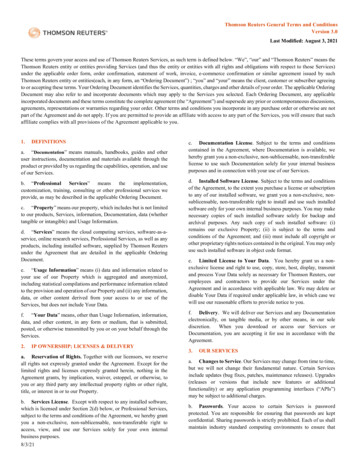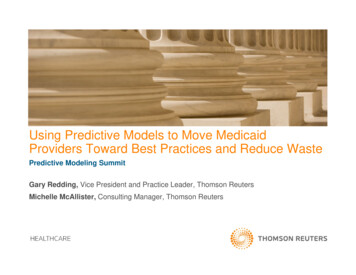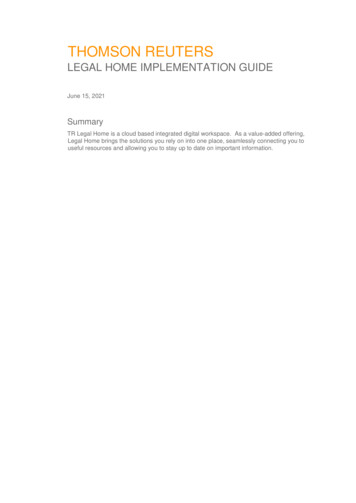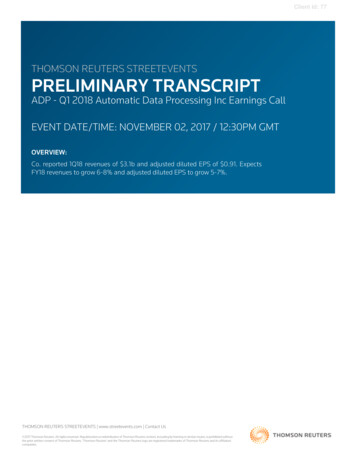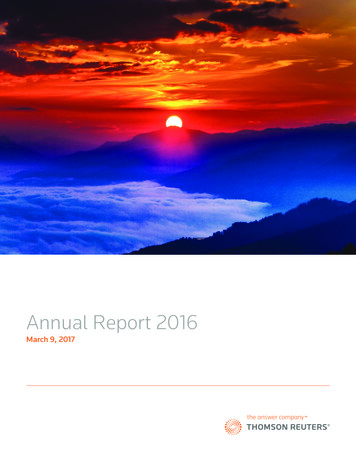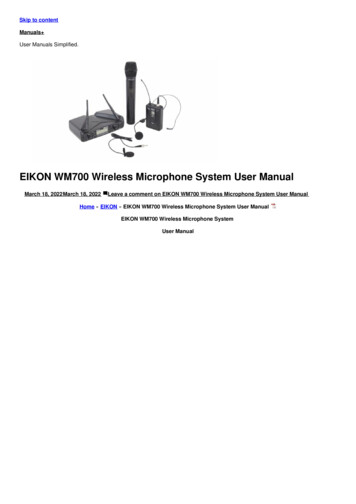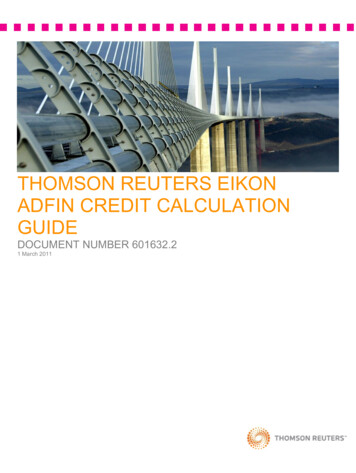
Transcription
THOMSON REUTERS EIKONADFIN CREDIT CALCULATIONGUIDEDOCUMENT NUMBER 601632.21 March 2011
Copyright 2005-2011 Thomson Reuters. All Rights Reserved.Republication or redistribution of Thomson Reuters content, including by framing or similar means, is prohibited without theprior written consent of Thomson Reuters. "Thomson Reuters" and the Thomson Reuters logo are trademarks of ThomsonReuters and its affiliated companies.Acknowledgement is made to all other brand or product names referred to in the text that are registered trademarks,trademarks, or trade names of their respective owners.Document HistoryDOCUMENT NUMBERDATEUPDATE601632.21 March 2011Reformatted "Where" tables601632.111 November 2010Renamed the calculation guide to Thomson ReutersEikon Adfin Credit Calculation Guide
THOMSON REUTERS EIKON ADFIN CREDIT CALCULATION GUIDETABLE OF CONTENTSTHOMSON REUTERS EIKON ADFIN CREDITCALCULATION GUIDE . 2CREDIT DERIVATIVES OVERVIEW . 3Credit Default Swaps (CDS) . 3Credit Link Notes (CLN) . 4RISK MODEL CALIBRATION. 5Calibration of the Credit Event Probability Curve . 5Calibration Examples in Thomson Reuters Eikon Excel . 14Calibration with Jarrow-Lando-Turnbull (JLT) Method . 18CDS PRICING AND EVALUATION . 25European CDS Pricing . 25American CDS Pricing . 35CDS Big Bang Impact on Pricing with Adfin . 43Credit Linked Note Pricing . 49Spread Calculation . 50COLLATERALIZED DEBT OBLIGATIONS. 51CDO Pricing . 51CDO Valuation . 53Implied Correlation . 56Example Using Thomson Reuters Eikon Excel . 56CDO References . 591
THOMSON REUTERS EIKON ADFIN CREDITCALCULATION GUIDEThe Adfin Credit Calculation Guide explains the Thomson Reuters Eikon Adfin credit functions, and their formulas to priceand analyze Credit Derivatives instruments such as Credit Default Swaps (CDS).A credit derivative is a derivative security for which payoff depends on the occurrence of a credit event. The aim of anymodel used in credit derivatives pricing is to express the credit risk linked to this type of instrument.For instance, a risky bond is a bond whose issuer can default. The most commonly used reference for indicating theprobability of default is the rating given to the firm by a rating agency, such as Standard & Poor’s or Moody’s. The lowerthe rating, the greater the risk of a bond issued by this firm defaulting before maturity. This risk is referred to as the defaultprobability.The most common way of pricing a bond is discounting all the cash flows using a zero-coupon curve. In order to take intoaccount the default risk of a risky bond, the principle will be similarly to discount the cash flows using a risky zero-couponcurve. Since this risky zero-coupon curve may not be available, we need to find a model for the default probability, whichwill allow us to go from the non-risky curve to the risky one.The model chosen makes it possible to price any instrument and take into account the risk. This requires calculation of thediscount factors of bonds, swaps and asset swaps.To avoid repetition, this book is organized according to calibration models, rather than credit derivative types. Thecalibration models described are: Credit event probability curve from a CDS spread curve or risky zero-coupon curve Cox-Ingersoll-Ross (CIR) coefficients from a CDS spread curve or risky zero-coupon curve Jarrow-Lando-Turnbull (JLT) method to reflect transitions between ratings and market informationFrom the calibration model, the Net Present Value and CDS Spread calculations are detailed using practical examples. Credit Derivatives Overview Risk Model Calibration CDS Pricing and Evaluation Collateralized Debt Obligations2Thomson Reuters Eikon Adfin CreditCalculation Guide
Credit Derivatives OverviewCREDIT DERIVATIVES OVERVIEWTerminologyCredit EventA default event, which can take different forms: bankruptcy, ratings downgrade,restructuring of debt, failure to meet a payment obligation.Recovery rateThe percentage of a claim that is recoverable in the event of counterparty to atransaction defaulting. Notation: R.CDSStands for Credit Default Swap.CLNStands for Credit Linked NotesThe type of contracts a buyer and seller can agree upon in case of a credit event are: Credit Default Swaps (CDS) Credit Link Notes (CLN)CREDIT DEFAULT SWAPS (CDS)PremiumProtection BuyerProtection SellerRisk SellerRisk BuyerNominalInterestContingent PaymentUnderlying AssetIn a credit default swap, the protection seller agrees to pay the contingent payment if the default has happened. If there isno default before the maturity of the credit default swap, the protection seller pays nothing.Three kinds of contingent payment exist: Cash settlement: the notional minus the market value of the reference asset after the default. Binary: a pre-agreed percentage of the notional amount Physical delivery: delivery of the reference asset.Extensions CDS callable: the risk seller has the right to cancel the CDS. The premium given to the risk buyer will be higher thanfor a straight CDS. CDS Quanto: the currency of the premium is different from the one of the underlying flows.3
CREDIT LINK NOTES (CLN)A credit-linked note is a combination of a default swap with a bond issued by the protection buyer.InterestProtection BuyerProtection SellerNominalRisk SellerNominalRisk BuyerInterestContingent Payment:Underlying AssetNominal if no Credit EventRecovery Value if CreditEvent4Thomson Reuters Eikon Adfin CreditCalculation Guide
Risk Model CalibrationRISK MODEL CALIBRATIONThis section describes the calibration of the different risk models, in order to set the default probability term structure. Thecalibrations are: Calibration of the Credit Event Probability Curve Calibration Examples in Thomson Reuters Eikon Excel Calibration with Jarrow-Lando-Turnbull (JLT) MethodCALIBRATION OF THE CREDIT EVENT PROBABILITY CURVECalibration of the Credit Event Probability Curve from a CDS Spread CurveThe idea is to compute the default probabilities given that an n-sized CDS spread curve, such as the net present value foreach of these CDS, is equal to zero. The calibration is done with a classical bootstrapping method: We assume that the default probability at time 0 is 0. Given the spread for a 1Y maturity CDS, we compute the default probability at time 1Y. Given the spread for a nY maturity CDS, we compute the default probability at time nY.If there are gaps in the CDS curve, we use the interpolation method linked to the Risk Model in order to calculate theconvenient default probabilities.Example in Thomson Reuters Eikon ExcelCreditStructure RISKMODEL:CURVE ND:DIS NBDAYS:146 RECOVERY:0.3 INSTTYPE:CDSRateStructureRM:YC ZCTYPE:DF IM LINCDS Spread Curve523-Sep-026M308.7CLDR:EMU FI DMC:M CDSTYPE:AMERCDS LFIXED FRQ:4CCM:MMA023-Sep-021Y312CLDR:EMU FI DMC:M CDSTYPE:AMERCDS LFIXED FRQ:4CCM:MMA023-Sep-022Y321.8CLDR:EMU FI DMC:M CDSTYPE:AMERCDS LFIXED FRQ:4CCM:MMA023-Sep-023Y320.1CLDR:EMU FI DMC:M CDSTYPE:AMERCDS LFIXED FRQ:4CCM:MMA023-Sep-024Y350.9CLDR:EMU FI DMC:M CDSTYPE:AMERCDS LFIXED FRQ:4CCM:MMA023-Sep-025Y362.7CLDR:EMU FI DMC:M CDSTYPE:AMERCDS LFIXED FRQ:4CCM:MMA023-Sep-027Y428CLDR:EMU FI DMC:M CDSTYPE:AMERCDS LFIXED FRQ:4CCM:MMA023-Sep-0210Y461.8CLDR:EMU FI DMC:M CDSTYPE:AMERCDS LFIXED FRQ:4CCM:MMA0
Risk-Free Zero Coupon 67.22%19-Sep-1263.90%Syntax AdCreditStructure(Risk-Free Zero Coupon Curve, CDS Spread Curve,“RISKMODEL:CURVE ND:DISNBDAYS:146 RECOVERY:0.3 INSTTYPE:CDS”,”RM:YC ZCTYPE:DF :CURVEthe credit event probability curveNBDAYS:ithe number of days per discrimination interval for pricing of American CDSRECOVERY:XXthe recovery rate value in percentageINSTTYPE:CDSthe model calibration by using a credit default swap curveResult returned by the function AdCreditStructure() returns:MATURITYDEFAULT homson Reuters Eikon Adfin CreditCalculation Guide
Risk Model CalibrationMATURITYDEFAULT Sep-200936.963514%24-Sep-201251.761091%Manual CalculationIn this part an explicit example focused on the first CDS is used to explain the calculation. To retrieve the whole defaultprobability curve by bootstrapping, the same method is used for all CDS.Default Probability Curve19-Sep-2002024-Mar-2003P(t T2) (unknown DP) 1%Where P(t T) is the probability that the credit event occurs at time t when T is the maturity date.We know that on the 19th September 2002, the default value is 0. Then we compute the default probability at period 6Mby solving the following problem:We assume that the unknown default probability (P(t T2)) on the 24th March 2003 is 1%. Note that to use the Excelsolver a value of P(t T2) has to be given as input.The value of the P(t T2) is the one which enables to return a Net Present Value of the CDS equal to 0. We use theAdCdsNpv() function for our calculations. For more information on how to calculate the Net Present Value of a CreditDefault Swap refer to CDS Pricing and Evaluation .Syntax 7, Risk-Free Zero Coupon Curve,Default probacurve,”CLDR:EMU FI DMC:M CDSTYPE:AMERCDS LFIXED FRQ:4 CCM:MMA0”,”RISKMODEL:CURVE RECOVERY:0.3NBDAYS:146 ND:DIS”,”RM:YC DEL:CURVEthe credit event probability curveNBDAYS:ithe number of days per discrimination interval for pricing of American CDSRECOVERY:XXthe recovery rate value in percentageCDSTYPE:AMERCDSan American CDS
Result returned by the function AdCdsNpv() returnsNpv-0.008596728To find P(t T2) we will solve the formula NPV 0 using the Excel solver for instance, we have:Default Probability 8%To calculate the next default probability, we use the part of the default probability curve already built. The date of theunknown default probability corresponds to the maturity date of the CDS.Calibration of the Credit Event Probability Curve from a Risky ZC CurveWe use the direct formula linking a risk-free zero-coupon price B(0,T), a risky zero-coupon price B’(0,T) and the recoveryrate R:DefaultP(T) B(0 , T) B' (0 , T)(1 R) B(0 , T)Example in Thomson Reuters Eikon ExcelRisk-Free Zero Coupon 70.75%19-Sep-1167.22%19-Sep-1263.90%Risky Zero Coupon %8Thomson Reuters Eikon Adfin CreditCalculation Guide
Risk Model ep-1240.92%Syntax AdCreditStructure(Risk-Free Zero Coupon Curve,Risky Zero Coupon Curve,"RISKMODEL:CURVE ND:DISRECOVERY:0.3 INSTTYPE:DF”,”RM:YC ZCTYPE:DF RVEthe credit event probability curveRECOVERY:XXthe recovery rate value in percentageINSTTYPE:DFthe model calibration by using a credit zero-coupon curveResult returned by the function AdCreditStructure() returns:MATURITYDEFAULT Sep-200936.683166%
MATURITYDEFAULT 14%19-Sep-201251.374916%Manual calculationAccording to the formula, we have on the 19th September 2003:DefaultP(T) B(0 , T) B' (0 , T) 96.73% 93.77% 4.371520%(1 R) B(0 , T) (1 30%) 96.73%To retrieve the whole default probability curve, the same method is used for all maturity dates.Calculation of Default Probabilities from the Credit Event Probability CurveFormulaP P(t 2 ) P(t 1 )1 P(t 1 )WHEREDENOTESPprobability to default between t1 and t2P(t1)interpolation from the input default probability curve at date t1P(t2)interpolation from the input default probability curve at date t2Example in Thomson Reuters Eikon ExcelThe default probability curve used in the following example is the one calculated from the CDS spread curve in theprevious section.Maturity 501-Jul-0501-Jan-0601-Jul-0601-Jan-0710Thomson Reuters Eikon Adfin CreditCalculation Guide
Risk Model Calibration01-Jul-0701-Jan-08DEFAULT PROBA CURVEDFI QUALSPeriod Start Date:01JAN03CreditStructure:RISKMODEL:CURVE ND:DISAdMode:LAY:HSyntax AdDefaultProba(“01JAN03”,Maturity Array,Default proba curve,“RISKMODEL:CURVE ESRISKMODEL:CURVEthe credit event probability curveResult returned by the function AdDefaultProba() returns:MATURITYDEFAULT 044.4760%01-Jul-046.7328%11
MATURITYDEFAULT Jul-0721.3541%01-Jan-0824.3433%Manual CalculationExample on the first default probability (01JUL03):t1: 01JAN03t2: 01JUL03P(01JAN03) 1.264% (This can be calculated using the AdInterp() function)P(01JUL03) 3.450%Then using the formula:P P(t 2 ) P(t 1 ) 3.450 % 1.264% 2.2140%1 P(t 1 )1 1.264%To retrieve the whole default probability curve, use the same formula for all maturity dates.Calibration of Cox Ingersoll Ross CoefficientsThe diffusion concerns the default intensity (notation: ht), which is defined as follows:Pr obability (default betw een t and t dt ) ht dtThe default intensity diffusion process is given by the CIR (Cox Ingersoll Ross) equation:dht (h ht ) dt ht dWt(1)WHEREDENOTESh long term intensityΛconvergence speedσvolatility coefficientWtBrownian motion under the neutral risk probabilityThe interest of this model is to ensure positive values for ht.If we consider a deterministic case, the equation (2) becomes:dht (h ht ) dtUsing equation (1), we can calculate the survival probability at time t: T (3)Q( T) E exp t hs ds12Thomson Reuters Eikon Adfin CreditCalculation Guide
Risk Model CalibrationUsing equation (2), the two probabilities useful for credit derivatives pricing have the following form:Survival probability: 1 e t Q( t) exp (h0 h ) h t (4) Default probability: 1 e t Q( t) 1 exp (h0 h ) h t (5)WHEREDENOTESh0initial intensityh long-term intensitytthe current timeTthe maturity of the instrumental, which is unknown the time of the defaultParametersh0, h and λ can be calibrated thanks to a CDS premium curve; the aim being the minimization of the distance betweenprices given by the model and prices given by the market.The credit derivatives market is not liquid enough to enable the calibration of σ. Moreover this parameter does not havemuch influence on credit derivatives prices; for this reason, the non-stochastic version of this model is implemented(sigma is considered null).Levenberg-Marquardt MethodSince Cox-Ingersoll-Ross is a parametric model and there is no simple formula to link the calibration inputs and outputs,we need a method to approximate the three coefficients describing this model.Adfin Analytics allows you, via AdCdsSpread(), to calculate the three intensity and convergence speed parameters of theCox, Ingersoll, and Ross model, using either an algorithm that links the spread to the maturity or the followingapproximated formula (in order to improve the performance):P I (1 R)I h (h0 h ) 1 e T TWHEREDENOTESIaverage default intensityPspread of the credit default swapRrecovery rateTmaturity of the credit default swapIn order to do so, we chose the non-linear square method of Levenberg-Marquardt. (Refer to the book Numerical Recipes,listed in the Bibliography on page 38).13
CALIBRATION EXAMPLES IN THOMSON REUTERS EIKON EXCELCalibration of Cox-Ingersoll-Ross Coefficients from a CDS Spread CurveCreditStructureRISKMODEL:CIR APPROX:YES NBDAYS:146 INSTTYPE:CDS RECOVERY:0.3RateStructureRM:YC ZCTYPE:DF IM:LINCDS Spread Curve23-Sep-026M308.7CLDR:EMU FI DMC:MCDSTYPE:AMERCDSLFIXED FRQ:4 CCM:MMA023-Sep-021Y312CLDR:EMU FI DMC:MCDSTYPE:AMERCDSLFIXED FRQ:4 CCM:MMA023-Sep-022Y321.8CLDR:EMU FI DMC:MCDSTYPE:AMERCDSLFIXED FRQ:4 CCM:MMA023-Sep-023Y320.1CLDR:EMU FI DMC:MCDSTYPE:AMERCDSLFIXED FRQ:4 CCM:MMA023-Sep-024Y350.9CLDR:EMU FI DMC:MCDSTYPE:AMERCDSLFIXED FRQ:4 CCM:MMA023-Sep-025Y362.7CLDR:EMU FI DMC:MCDSTYPE:AMERCDSLFIXED FRQ:4 CCM:MMA023-Sep-027Y428CLDR:EMU FI DMC:MCDSTYPE:AMERCDSLFIXED FRQ:4 CCM:MMA023-Sep-0210Y461.8CLDR:EMU FI DMC:MCDSTYPE:AMERCDSLFIXED FRQ:4 CCM:MMA0Risk-Free Zero Coupon %19-Sep-0589.87%19-Sep-0686.05%14Thomson Reuters Eikon Adfin CreditCalculation Guide
Risk Model %Syntax AdCreditStructure(Risk-Free Zero Coupon Curve,Risky Zero Coupon Curve,“RISKMODEL:CIR APPROX:YESINSTTYPE:DF RECOVERY:0.3”, “RM:YC ZCTYPE:DF IESRISKMODEL:CIRthe Cox-Ingersoll-Ross modelRECOVERY:XXthe recovery rate value in percentageINSTTYPE:DFthe model calibration by using a credit zero-coupon curveResult returned by the function AdCreditStructure() returns:Default intensity start value0.032410Default intensity long term value0.141134Default intensity convergence speed0.100831Calculation of Default Probabilities from Cox-Ingersoll-Ross CoefficientsAccording to the previous part, we know that:Default probability equals to: 1 e t Q( t) 1 exp (h0 h ) h t WHEREDENOTESh initial intensitytthe current time15
WHEREDENOTESTthe maturity of the instrumental, which is unknown the time of the defaultThe default probability curve used in the following example is the one calculated from the CDS spread curve in theprevious section.Maturity an-08CIR Array0.0400890.1011710.10975016Thomson Reuters Eikon Adfin CreditCalculation Guide
Risk Model CalibrationPeriod Start Date01JAN03CreditStructureRISKMODEL:CIR ND:DISAdModeLAY:HSyntax AdDefaultProba(“01JAN03”,Maturity Array,CIR Array,“RISKMODEL:CIR IESRISKMODEL:CIRthe Cox-Ingersoll-Ross modelResult returned by the function AdDefaultProba() returns:MATURITYDEFAULT 8.6922%01-Jul-0721.1870%01-Jan-0823.7234%17
Manual CalculationExample on the first default probability (01JUL03):So we haveT0.495890*h00.040089h 0.101171λ0.109750*Can be calculated using the DfCountYears() function.Then using the formula: 1 e( t )1 e( 0.109750 0.495890 )Q( t ) 1 exp (h0 h ) h t 1 exp (0.040089 0.101171) 0.101171 0.495890 2.0476% 0.109750 To retrieve the whole default probability curve, use the same formula for all maturity dates.CALIBRATION WITH JARROW-LANDO-TURNBULL (JLT) METHODMarkov ModelThe Jarrow, Lando and Turnbull model is based on the assumption that the bankruptcy process follows a discrete statespace Markov chain in credit ratings.The stability of this model has been enhanced by Kijima and Komoribayashi.Markov ChainLet Q(K,K) be the transition matrix defining the Markov process, where the (K – 1)th line corresponds to the lower creditrating class, and the Kth line represents the bankruptcy state: it is also called the absorbing state of this process, since thefirm’s rating cannot change after bankruptcy. The element of the matrix Q, qi,j , is the probability for a bond which rating isi to become rated j within a time step. q 1, 1 . q K 1, 1 0q 1,2.0q 1,K . . q K 1,K 00 .Approximations of the qi,j can be found in Moody’s or Standard & Poor’s reports, available athttp://www.reuters.com/credit.Here is an example for bonds maturing in one year. The matrix line stands for the rating after transition, and the matrixcolumn stands for the base rating.Transition MatrixThe aim is now to compute the transition matrix for going from step t to step t 1. The matrix Q’t,t 1 is written as follows : q' 1, 1 (t , t 1) q' 1,2 . q' K 1, 1 (t , t 1) 0 (t , t 1) .018Thomson Reuters Eikon Adfin CreditCalculation Guideq' 1,K (t , t 1) . . q' K 1,K (t , t 1) 00
Risk Model CalibrationAaABaaBaBCaaDAaaAaABaa0 .01080 .00060 .00050 .00030 .0001000 .8870 .02880 .00340 .00080 .0004000 .09550 .90210 .07070 .00560 .00170 .006600 .00340 .05920 .85240 .05680 .00650 .01050BaB0 .0015 0 .00150 .0074 0 .00180 .0605 0 .01010 .8357 0 .08080 .0659 0 .8270 .0305 0 .061100Jarrow and al.(1997) assume that the q’i,j(t,t 1) can be calculated using:q' i,j (t , t 1) i (t ) qi,jWhere(6) i (t ) is a deterministic function of time that ensures that:q' i , j (t , t 1) 0 , i, j, i j K q' i,j (t , t 1) 1 j 1 Using a matrix notation this can be summarized by:Q' t ,t 1 Ik (t ) (Q Ik )Where(7) (t ) is a diagonal matrix with the i (t ) on the diagonal and Ik is a null matrix with 1 in the last column (k).EvaluationThe aim of this part is to evaluate ( 1(t ) , K 1(t ) for t 0, 1 )iLet v (t , T) be the price of a risky zero-coupon of maturity T issued by a firm in credit class I at time t. We know that:vi (t , T) p(t , T) R (1 R) Q' it ( T) Where p(t,T) is a default free zero coupon, R the recovery rate andbefore maturity.Q' it ( T) the probability that the firm will not defaultIf we assume that we have for each credit class and for each maturity a default free zero coupon and a risky zero coupon,Kijima and al. give formulas to find the values of theFor t 0: i (0 ) 191vi (0 ,1) R p(0 ,1) 1 q j ,kp(0 ,1) (1 R)for i 1.K-1 (9) i (t ) .
Assuming thatQ' 0 1,texists, forK i (t ) q' i , j1 (0 , t ) j 1t 1. :vi (0 , t 1) R p(0 , t 1)p(0 , t 1) (1 R) (1 qik )Default ProbabilityThe survival probability can now be expressed as follows:K 1Q' it ( T) q' i , j (t , T) 1 q'i ,K (t , T)j 1Knowing this probability, the credit derivatives prices can be calculated.Example in Thomson Reuters Eikon ExcelWe want to calibrate a downgrade probability curve from a transition matrix using Jarrow, Lando and Turnbull model for asingle A bond that remains single A at the credit event date (RATING:1 to CREDITEVENT:1).Transition matrix for Rating:i along Y-axis and Credit event:j along X-axisTRANSITION 0.3D0001Risk Free %RISKY CURVE ARISKY CURVE BRISKY CURVE 0%74.00%17-Jul-0485.00%74.00%63.00%20Thomson Reuters Eikon Adfin CreditCalculation Guide
Risk Model CalibrationRecovery rate:50%RateStructure:RM:YC ZCTYPE:DFCreditStructure:RISKMODEL:CURVE INSTTYPE:DF RECOVERY:0.5RATING:1 CREDITEVENT:1In this example the return value of the AdJLTCreditStructure() function is retrieved and then the formula to recalculatethe result is applied manually.Syntax AdJLTCreditStructure(RiskFree Curve,Risky Curve, Transition Matrix, “RISKMODEL:CURVE RECOVERY:0.5RATING:1 CREDITEVENT:1”,”RM:YC DEL:CURVEthe credit event probability curveRECOVERY:XXthe recovery rate value in percentageRATING:ithe issuing firm rating expressed as the column number in the transition matrixCREDITEVENT:ithe rating which corresponds to the credit eventResult returned by the function AdJLTCreditStructure() .17%Manual CalculationIn this part, an explicit example focused on all transition matrix and probability date is used to explain the calculation. 0 0Ik 0 0 000000001 1 1 1 0 .95 0 .3 001 0 .01 0 .1 0 .7 0 .1 0 .1 Q 0 .1 0 .2 0 .4 0 .3 0001 WHEREDENOTESIkA null matrix with 1 in the last columnQThe transition matrix21
T 0: Q’(0,1) calculation: Downgrade probability matrix from RATING:i to CREDITEVENT:j from the 17JUL02 to the17JUL03Q' 0 ,1 Ik (0 ) (Q Ik )According to the equation (9): 1(0 ) 1v 1(0 ,1) R p(0 ,1)189% 50% 89.9% 0.9898771 q 1,4p(0 ,1) (1 R)1 0.01 89.9% (1 50%) 2 (0 ) 1v 2 (0 ,1) R p(0 ,1)184.5% 50% 89.9% 0.9776291 q2,4p(0 ,1) (1 R)1 0.184.5% (1 50%) 3 (0 ) 1v 3 (0 ,1) R p(0 ,1)174% 50% 89.9% 0.9232481 q 3,4p(0 ,1) (1 R)1 0.174% (1 50%) 4 (0 ) 1With the matrix 0 .989877 0 .977629 L(0 ) 0 .923248 1 000 0 .989877 00 .97762900 (0 ) 000 .923248 0 0001 and therefore 0 .95 0 .3 001 0 .99 0 .1 0 .7 0 .1 0 .9 Q Ik 0 .1 0 .2 0 .4 0 .7 0000 AndThen we have:000 0.940383 0.029696 0.009899 0 .97998 0.95 0.3 001 0 .99 0 .989877 00.97762900 0.097763 0.684341 0.097763 0.87987 0.1 0.7 0 .1 0 .9 (0 ).(Q Ik ) . 0.1 0 .2 0 .4 0 .7 000 .923248 0 0.092325 0 .18465 0.369299 0 .64627 0 000 0001 0000 000 0 0 0 0 .95 0 .3 001 0 .99 0 .989877 00 .97762900 0 0 0 0 .1 0 .7 0 .1 0 .9 Q' (0 ,1) (0 ).(Q Ik ) Ik . 0 .1 0 .2 0 .4 0 .7 000 .923248 0 0 0 0 0000 0001 0 0 0 0 .940383 0 .029696 0 .009899 0 .97998 0 0 0 1 0 .940383 0 .029696 0 .009899 0 .097763 0 .684341 0 .097763 0 .87987 0 0 0 1 0 .097763 0 .684341 0 .097763 0 .092325 0 .18465 0 .369299 0 .64627 0 0 0 1 0 .092325 0 .18465 0 .369299 0 0 0 1 0000000 1 1 1 1 0 .020022 0 .120133 0 .353726 1 T 1: Q’(1,2) calculation: Downgrade probability matrix from RATING:i to CREDITEVENT:j from the 17JUL03 to the 17JUL04Q' 1,2 Ik (1) (Q Ik )22Thomson Reuters Eikon Adfin CreditCalculation Guide
Risk Model CalibrationAccording to the equation (9):v 1(0 ,2) R p(0 ,2) 85% 50% 86% 0.976744p(0 ,2) (1 R)86% (1 50%)v 2 (0 ,2) R p(0 ,2) 74% 50% 86% 0.72093p(0 ,2) (1 R)86% (1 50%)v 3 (0 ,2) R p(0 ,2) 63% 50% 86% 0.465116p(0 ,2) (1 R)86% (1 50%)With 0 .976744 0 .72093 L' (1) 0 .465116 1 1.069459 0.04165 0.01764 0.01017 0.1234 1.578471 0.41455 0.04052 Q 1 0.20567 0.77882 2.919518 0.93503 0001 1 1 1 0.01 1.069459 0.04165 0.01764 0.01017 0.976744 0.01 1.006357 0.01 1.016522 1 0.1234 1.578471 0.41455 0.04052 0.72093 1 0.824622 1 0.916247 L(1) Q 1.L' (1) . 0.1 . . 0.1 . 0.1 1 0.20567 0.77882 2.919518 0.93503 0.465116 1 0.595556 1 0.850794 0001101 0.3 0.3 0.3 1 1 1 000 1.016522 00 .91624700 (1) 000 .850794 0 0001 and therefore, 0 .95 0 .3 001 0 .99 0 .1 0 .7 0 .1 0 .9 Q Ik 0 .1 0 .2 0 .4 0 .7 0 000 AndThen we have:000 0.965696 0.030496 0.010165 1.00636 0.95 0.3 001 0.99 1.016522 0.10.70.1 0.900.91624700 0.091625 0.641373 0.091625 0.82462 (1).(Q Ik ) . 0.1 0.2 0.4 0.7 000.850794 0 0.085079 0.170159 0.340318 0.59556 0 000 0001 0000 23
0 .95 0 .3 001 0 .99 1.016522 0 0 .1 0 .7 0 .1 0 .9 Q' (1,2) (1).(Q Ik ) Ik . 0 .1 0 .2 0 .4 0 .70 0 0000 0 .965696 0 .030496 0 .010165 1.00636 0 0 0 0 .091625 0 .641373 0 .091625 0 .82462 0 0 0 0 .085079 0 .170159 0 .340318 0 .59556 0 0 0 0 0 00000 000 0 0 0 0 .91624700 0 0 0 00 .850794 0 0 0 0 001 0 0 01 0 .965696 0 .030496 0 .010165 1 0 .091625 0 .641373 0 .091625 1 0 .085079 0 .170159 0 .340318 1 0001 1 1 1 0 .00636 0 .175378 0 .40444 1 Therefore the downgrade probability matrix from RATING:i to CREDITEVENT:j from the 17JUL02 to the 17JUL04 is: 0 .965696 0 .030496 0 .010165 0 .00636 0 .940383 0 .029696 0 .009899 0 .020022 0 .091625 0 .641373 0 .091625 0 .175378 0 .097763 0 .684341 0 .97763 0 .120133 Q' (0 ,2) Q' (1,2).Q' (0 ,1) .0 .085079 0 .170159 0 .340318 0 .40444 0 .092325 0 .18465 0 .369299 0 .353726 00010001 0 .911687 0 .049408 0 .015649 0 .023256 0 .165429 0 .458534 0 .096967 0 .27907 0 .137496 0 .184084 0 .143536 0 .534884 0001 In our example, we need the downgrade probability table (here given to two decimal places) from RATING:1 toCREDITEVENT:1. We can retrieve these values from the 0491.17%**** On 17th July 2002 the downgrade probab
The Adfin Credit Calculation Guide explains the Thomson Reuters Eikon Adfin credit functions, and their formulas to price and analyze Credit Derivatives instruments such as Credit Default Swaps (CDS). A credit derivative is a derivative security for which payoff depends on the occurrence of a credit event. The aim of any


